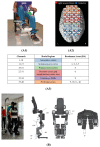fNIRS-EEG BCIs for Motor Rehabilitation: A Review
- PMID: 38135985
- PMCID: PMC10740927
- DOI: 10.3390/bioengineering10121393
fNIRS-EEG BCIs for Motor Rehabilitation: A Review
Abstract
Motor impairment has a profound impact on a significant number of individuals, leading to a substantial demand for rehabilitation services. Through brain-computer interfaces (BCIs), people with severe motor disabilities could have improved communication with others and control appropriately designed robotic prosthetics, so as to (at least partially) restore their motor abilities. BCI plays a pivotal role in promoting smoother communication and interactions between individuals with motor impairments and others. Moreover, they enable the direct control of assistive devices through brain signals. In particular, their most significant potential lies in the realm of motor rehabilitation, where BCIs can offer real-time feedback to assist users in their training and continuously monitor the brain's state throughout the entire rehabilitation process. Hybridization of different brain-sensing modalities, especially functional near-infrared spectroscopy (fNIRS) and electroencephalography (EEG), has shown great potential in the creation of BCIs for rehabilitating the motor-impaired populations. EEG, as a well-established methodology, can be combined with fNIRS to compensate for the inherent disadvantages and achieve higher temporal and spatial resolution. This paper reviews the recent works in hybrid fNIRS-EEG BCIs for motor rehabilitation, emphasizing the methodologies that utilized motor imagery. An overview of the BCI system and its key components was introduced, followed by an introduction to various devices, strengths and weaknesses of different signal processing techniques, and applications in neuroscience and clinical contexts. The review concludes by discussing the possible challenges and opportunities for future development.
Keywords: brain–computer interface; electroencephalography; functional near-infrared spectroscopy; motor imagery; motor rehabilitation; multimodal.
Conflict of interest statement
The authors declare no conflict of interest.
Figures






References
-
- Cieza A., Causey K., Kamenov K., Hanson S.W., Chatterji S., Vos T. Global Estimates of the Need for Rehabilitation Based on the Global Burden of Disease Study 2019: A Systematic Analysis for the Global Burden of Disease Study 2019. Lancet. 2020;396:2006–2017. doi: 10.1016/S0140-6736(20)32340-0. - DOI - PMC - PubMed
-
- Hatem S.M., Saussez G., della Faille M., Prist V., Zhang X., Dispa D., Bleyenheuft Y. Rehabilitation of Motor Function after Stroke: A Multiple Systematic Review Focused on Techniques to Stimulate Upper Extremity Recovery. Front. Hum. Neurosci. 2016;10:422. doi: 10.3389/fnhum.2016.00442. - DOI - PMC - PubMed
-
- Ang K.K., Guan C. Brain-Computer Interface in Stroke Rehabilitation. J. Comput. Sci. Eng. 2013;7:139–146. doi: 10.5626/JCSE.2013.7.2.139. - DOI
Publication types
Grants and funding
LinkOut - more resources
Full Text Sources

